Tuesday, March 13, 2012
Hello! I hope you read this post about all things oysters. And then you must check out my recipe for spicy-sweet mignonette.
—
Cooking & Eating the PK Way: The Oyster Exemplar
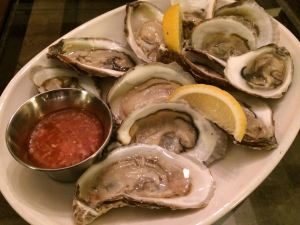 Oysters are reputed to be an aphrodisiac, and I’ll let you reach your own conclusions as to whether that’s fact or fiction. I personally do not have an oyster fetish, though I’ll bet at least some of my readers living here in New England do. But I have been thinking about oysters a lot since I began buying them at my local farmers’ market and shucking them at home. Oysters also epitomize my blog’s themes of healthy, sustainable, and delicious eating. Now, even if you don’t eat oysters, please keep reading this “farm to fork” story of why what you eat matters. I’ll discuss environmental aspects as well as nutritional considerations and provide lots of links for you to learn more about this shellfish and seafood in general. The final section highlights two of my culinary adventures with oysters, fried and raw.
Oysters are reputed to be an aphrodisiac, and I’ll let you reach your own conclusions as to whether that’s fact or fiction. I personally do not have an oyster fetish, though I’ll bet at least some of my readers living here in New England do. But I have been thinking about oysters a lot since I began buying them at my local farmers’ market and shucking them at home. Oysters also epitomize my blog’s themes of healthy, sustainable, and delicious eating. Now, even if you don’t eat oysters, please keep reading this “farm to fork” story of why what you eat matters. I’ll discuss environmental aspects as well as nutritional considerations and provide lots of links for you to learn more about this shellfish and seafood in general. The final section highlights two of my culinary adventures with oysters, fried and raw.
* * * * *
Environmental Sustainability: Local and Beyond
“Teach someone to fish, and you will feed them for a lifetime…Teach enough people to grow fish and you will feed the world.” This is the motto of the Island Creek Oysters Foundation and you should check out their site for more information on the great work this organization is doing both here in Massachusetts and  around the world. Bostonians may recognize the words “Island Creek.” Is it your favorite oyster to shuck, slurp, and sup from Duxbury, Massachusetts? Is the titular Island Creek Oyster Bar your new favorite spot in the Fenway, or do you frequent other like restaurants such as Lineage in Brookline? Did you regularly attend the oyster festival each September, which raised more than half a million bucks for incredibly worthy causes here and abroad? Learn more here about this tasty oyster, which supports local farmers, businesses, and communities in an environmentally sustainable way. There are also many other local oysters you can enjoy that are locally sourced and sustainably raised, both here in Massachusetts and perhaps someplace near you.
around the world. Bostonians may recognize the words “Island Creek.” Is it your favorite oyster to shuck, slurp, and sup from Duxbury, Massachusetts? Is the titular Island Creek Oyster Bar your new favorite spot in the Fenway, or do you frequent other like restaurants such as Lineage in Brookline? Did you regularly attend the oyster festival each September, which raised more than half a million bucks for incredibly worthy causes here and abroad? Learn more here about this tasty oyster, which supports local farmers, businesses, and communities in an environmentally sustainable way. There are also many other local oysters you can enjoy that are locally sourced and sustainably raised, both here in Massachusetts and perhaps someplace near you.
Oysters are the “Best of the Best” when it comes to seafood, according to Monterey Bay Aquarium’s recent State of Seafood report. You are certainly cognizant that conscientiously consuming seafood can be a conundrum, yes? Said without the gratuitous  here.) The Monterey Bay Aquarium Seafood Watch, National Geographic, and Blue Ocean Institute are three great resources to get you started on selecting sustainable seafood like farmed oysters.
here.) The Monterey Bay Aquarium Seafood Watch, National Geographic, and Blue Ocean Institute are three great resources to get you started on selecting sustainable seafood like farmed oysters.
* * * * *
What About Me? Individual Health and Nutrition
High in nutrients, low in calories. Americans consume far less seafood than recommended for health, and here’s an opportunity to do so sustainably. Oysters are nutrient-dense and energy-dilute, geeky ways of saying they are rich in all kinds of vitamins and minerals and have amazingly few calories—only about 120 kcal or so for an entire dozen on the half shell! The fats they do have are mainly the “good” polyunsaturated fats, heart- and brain-healthy omega-3s. A good non-dairy source of calcium, they are also high in minerals zinc, copper, selenium, manganese, phosphorous, and potassium and vitamins C, A, and several B vitamins. A lot of nutrition is packed into this bivalve mollusk! Precise mineral composition differs by terroir—hence taste—as oysters take on the flavor of where they are grown and harvested.
Safety concerns. There are risks of food-borne illness associated with consuming a number of foods, including seafood; risks are heightened when foods are uncooked, such as raw oysters. The FDA has some good information here, if you like, with specific notes on oysters about half-way down the page. Do also be careful if you are shucking the oysters at home to avoid stabbing yourself. If these are happy hour fare, you might (strongly) consider shucking before drinking, as I mentioned the other day.
* * * * *
Oyster Confessions: The Fried and the Raw
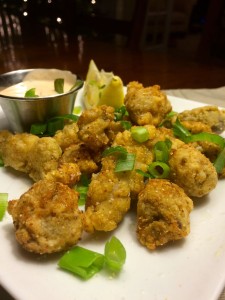 I love fried oysters, and I’ve posted a photo of glorious cornmeal-crusted fried oysters with spicy aioli here to prove it. So let’s start with the fried, because… well, do I really need to justify why I’m starting with fried? Even non-seafood eaters tend to like fried seafood. (Wait a second … my mind just wandered to my best fish and chips ever experience last October in London on Apple Day…must eat again…checking flights to Heathrow … ooooooohhh…)
I love fried oysters, and I’ve posted a photo of glorious cornmeal-crusted fried oysters with spicy aioli here to prove it. So let’s start with the fried, because… well, do I really need to justify why I’m starting with fried? Even non-seafood eaters tend to like fried seafood. (Wait a second … my mind just wandered to my best fish and chips ever experience last October in London on Apple Day…must eat again…checking flights to Heathrow … ooooooohhh…)
Where was I? (That fish and chips was so friggin’ great!) Fried seafood. Or, as my husband and I like to say, “fried fried.” Which is to say if you have a light-as-air, oh-so-crispy beer batter does it really even matter what’s inside? Yeah, exactly. That said, I’ve had my fair share of fried seafood that’s not worth its calories. But really fabulous fried oysters are unbelievable. Succulent and sweet, they tend to be larger and more flavorful than clams—though I also love those—and are one of my favorite indulgences when I dine out. Those at Atlantic Fish are incredibly delicious, for example, served with their spicy cajun remoulade. So, yes, this nutrition scientist eats fried food—in moderation, of course.
I was until recently a raw oyster virgin. I only started shooting oysters a year or so ago. It was my husband who always ordered them, which I continue to find ironic because he never ate seafood before we met, minus the occasional sushi outting with friends. An adventurous eater, he starting eating them a bunch of years back, way before me. Now he’s an addict, ordering them on pretty much any occasion he can. He also prefers a simple squeeze of lemon to the traditional accoutrements (horseradish, cocktail sauce, and mignonette), though I did convince him to taste my rocking spicy-sweet mignonette. He’s definitely more of a connoisseur than I, loving all types of oysters including the much stronger specimens we tasted in Australia. My point? Never say never. Try new foods, and try ’em again. You just might surprise yourself. Oysters also vary in taste and size, so don’t give up if you hate it the first time around. Oftentimes you can order just one, so try a a few and experience the differences. Be adventurous, and go for it!

So there you have it! See why I wanted to write about oysters today? Oysters bring all of the themes of the blog together healthfully, sustainably, and delectably. Not a meat eater of any kind? Never, ever gonna eat oysters? That’s cool, too. Just remember that this type of farm-to-fork thinking can be applied to everyday food choices. The key is to consider why what you eat matters, for your body and beyond. And then? Dig in!

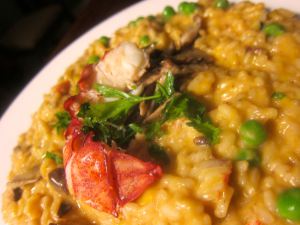
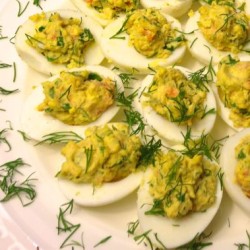
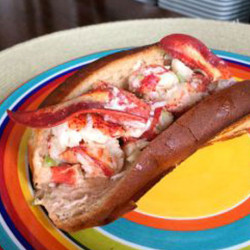
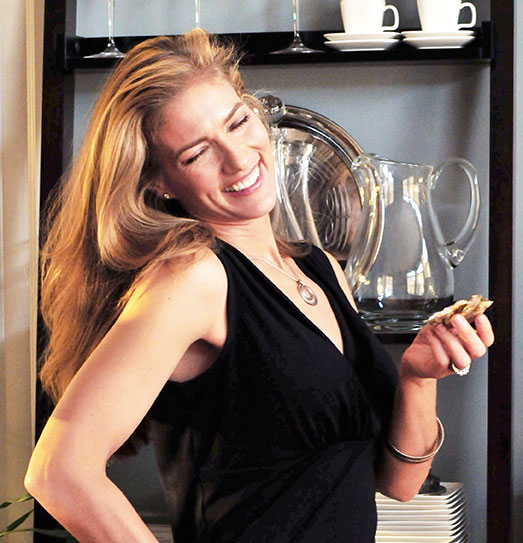
Great post – always happy to have more reasons to eat oysters!
Thanks for the comment & visit, Myrna! Let’s get shucking!